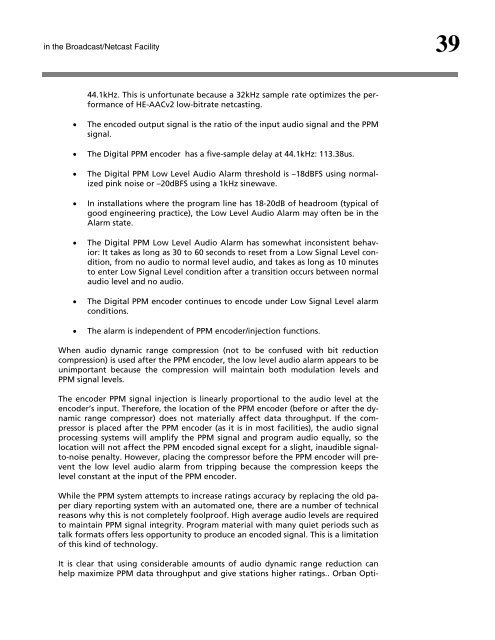Maintaining Audio Quality in the Broadcast Facility 2011 - Orban
Maintaining Audio Quality in the Broadcast Facility 2011 - Orban
Maintaining Audio Quality in the Broadcast Facility 2011 - Orban
You also want an ePaper? Increase the reach of your titles
YUMPU automatically turns print PDFs into web optimized ePapers that Google loves.
<strong>in</strong> <strong>the</strong> <strong>Broadcast</strong>/Netcast <strong>Facility</strong> 39<br />
44.1kHz. This is unfortunate because a 32kHz sample rate optimizes <strong>the</strong> performance<br />
of HE-AACv2 low-bitrate netcast<strong>in</strong>g.<br />
� The encoded output signal is <strong>the</strong> ratio of <strong>the</strong> <strong>in</strong>put audio signal and <strong>the</strong> PPM<br />
signal.<br />
� The Digital PPM encoder has a five-sample delay at 44.1kHz: 113.38us.<br />
� The Digital PPM Low Level <strong>Audio</strong> Alarm threshold is –18dBFS us<strong>in</strong>g normalized<br />
p<strong>in</strong>k noise or –20dBFS us<strong>in</strong>g a 1kHz s<strong>in</strong>ewave.<br />
� In <strong>in</strong>stallations where <strong>the</strong> program l<strong>in</strong>e has 18-20dB of headroom (typical of<br />
good eng<strong>in</strong>eer<strong>in</strong>g practice), <strong>the</strong> Low Level <strong>Audio</strong> Alarm may often be <strong>in</strong> <strong>the</strong><br />
Alarm state.<br />
� The Digital PPM Low Level <strong>Audio</strong> Alarm has somewhat <strong>in</strong>consistent behavior:<br />
It takes as long as 30 to 60 seconds to reset from a Low Signal Level condition,<br />
from no audio to normal level audio, and takes as long as 10 m<strong>in</strong>utes<br />
to enter Low Signal Level condition after a transition occurs between normal<br />
audio level and no audio.<br />
� The Digital PPM encoder cont<strong>in</strong>ues to encode under Low Signal Level alarm<br />
conditions.<br />
� The alarm is <strong>in</strong>dependent of PPM encoder/<strong>in</strong>jection functions.<br />
When audio dynamic range compression (not to be confused with bit reduction<br />
compression) is used after <strong>the</strong> PPM encoder, <strong>the</strong> low level audio alarm appears to be<br />
unimportant because <strong>the</strong> compression will ma<strong>in</strong>ta<strong>in</strong> both modulation levels and<br />
PPM signal levels.<br />
The encoder PPM signal <strong>in</strong>jection is l<strong>in</strong>early proportional to <strong>the</strong> audio level at <strong>the</strong><br />
encoder’s <strong>in</strong>put. Therefore, <strong>the</strong> location of <strong>the</strong> PPM encoder (before or after <strong>the</strong> dynamic<br />
range compressor) does not materially affect data throughput. If <strong>the</strong> compressor<br />
is placed after <strong>the</strong> PPM encoder (as it is <strong>in</strong> most facilities), <strong>the</strong> audio signal<br />
process<strong>in</strong>g systems will amplify <strong>the</strong> PPM signal and program audio equally, so <strong>the</strong><br />
location will not affect <strong>the</strong> PPM encoded signal except for a slight, <strong>in</strong>audible signalto-noise<br />
penalty. However, plac<strong>in</strong>g <strong>the</strong> compressor before <strong>the</strong> PPM encoder will prevent<br />
<strong>the</strong> low level audio alarm from tripp<strong>in</strong>g because <strong>the</strong> compression keeps <strong>the</strong><br />
level constant at <strong>the</strong> <strong>in</strong>put of <strong>the</strong> PPM encoder.<br />
While <strong>the</strong> PPM system attempts to <strong>in</strong>crease rat<strong>in</strong>gs accuracy by replac<strong>in</strong>g <strong>the</strong> old paper<br />
diary report<strong>in</strong>g system with an automated one, <strong>the</strong>re are a number of technical<br />
reasons why this is not completely foolproof. High average audio levels are required<br />
to ma<strong>in</strong>ta<strong>in</strong> PPM signal <strong>in</strong>tegrity. Program material with many quiet periods such as<br />
talk formats offers less opportunity to produce an encoded signal. This is a limitation<br />
of this k<strong>in</strong>d of technology.<br />
It is clear that us<strong>in</strong>g considerable amounts of audio dynamic range reduction can<br />
help maximize PPM data throughput and give stations higher rat<strong>in</strong>gs.. <strong>Orban</strong> Opti-



![[PDF] Using the ITU BS.1770-2 and CBS Loudness Meters ... - Orban](https://img.yumpu.com/50629372/1/190x245/pdf-using-the-itu-bs1770-2-and-cbs-loudness-meters-orban.jpg?quality=85)






![[PDF] Optimod-FM Feature Comparison - Orban](https://img.yumpu.com/41741615/1/190x245/pdf-optimod-fm-feature-comparison-orban.jpg?quality=85)






